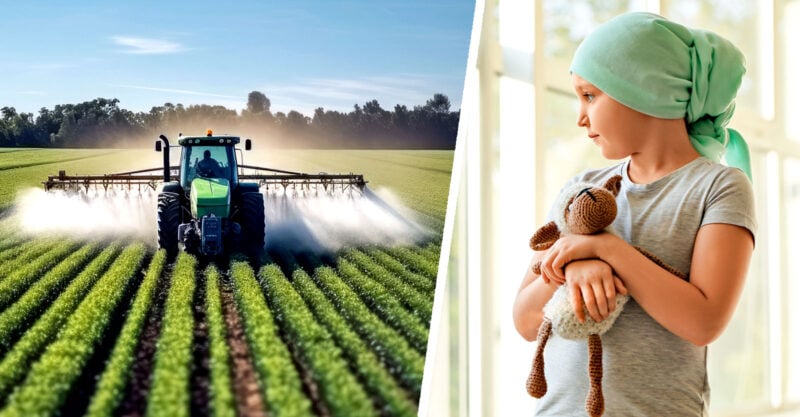10 Years of Studies Link Pesticide Exposure and Childhood Cancer
A meta-analysis of 174 studies published in the International Journal of Molecular Science between 2013 and 2023 found that more than 80% showed positive associations between pesticide exposure and heightened risk of childhood cancers.
Source: The Defender, Original by Beyond Pesticides
Researchers at the National Institute of Pediatrics and National Polytechnic Institute found positive associations between pesticide exposure and heightened risk of certain childhood cancers.
The finding is derived from a meta-analysis of 174 studies published between 2013 and 2023 and published in the International Journal of Molecular Science.
The authors noted:
“Although [pesticide exposure] association with childhood cancer has not been fully demonstrated, we found that more than 80% of the epidemiological studies show positive associations [with forms of childhood cancer].”
Approximately one-third of identified studies (roughly 16) find positive relationships between prenatal and postnatal pesticide exposure with a heightened risk of leukemia, neuroblastoma and rare forms of cancer, such as Wilms tumor.
For central nervous system (CNS) tumors, half of the identified studies (roughly 24) found a positive relationship with pesticide exposure.
The researchers called on further research regarding the interaction between different pesticides and health impacts on cumulative exposure.
The study is broad in scope, identifying various environmental pollutants and their associations with certain childhood cancers (e.g. radon exposure, air pollution, electromagnetic fields, indoor chemicals and tobacco and alcohol).
This Daily News focuses specifically on pesticide exposure. The researchers originally identified 6,172 studies through PubMed, however, 174 studies were ultimately included after two rounds of screening with the three following criteria:
- “Original or review epidemiological studies assessing the association between environmental pollution and childhood cancer;
- Published between 2013–2023; and,
- With abstracts in English or Spanish.”
Table 3 in the Results section identified the running list of studies assessing pesticide exposure and risk of childhood cancer.
Out of the 376 papers initially pulled from the database using the keywords “children,” “cancer” and “pesticides,” the researchers included 49 articles following the criteria listed above.
Regarding the type of exposure, 34% focused on parental exposure to pesticides, 24% focused on postnatal exposure and 27% focused on maternal/prenatal exposure — a relatively even distribution of potential avenues for pesticide harm.
Studies that fall under the category of “childhood cancer” typically refer to studies that investigate more than one type of cancer.
In the conclusion subsection on pesticides, researchers arrived at several determinations:
“Importantly, our results revealed a high percentage of studies showing associations between CNS tumors, neuroblastoma and pesticides (Figure 7).
“The mechanisms assessing the potential relationship of pesticides with these types of cancer should be explored.
“Although the genotoxicity of pesticides has been evaluated, their epigenetic effects need to be fully investigated because their contribution to childhood cancer etiology could be at this level.
“In addition, although the risks of pesticide exposure have been vastly evaluated, the transgenerational effects of these exposures need more attention.
“It has been shown that the environmentally induced disease risk can be transmitted to the offspring, via epigenetic mechanisms through female and male germ lines.”
The findings from the studies in the meta-analysis do not come as a surprise for advocates who have witnessed the adverse health impacts of pesticide exposure on chemically sensitive populations such as children.
In “Children and Pesticides Don’t Mix,” Beyond Pesticides outlines the myriad health risks associated with childhood exposure to pesticides that corroborate the findings of this more recent study.
For example, a 2015 meta-analysis study by scientists at Harvard University’s School of Public Health found that children’s exposure to pesticides in and around the home resulted in an increased risk of developing certain childhood cancers.
Authors found that cancer risk is connected most closely to the type of pesticide used and its application location.
A 2024 Environmental Research study found an association between adverse neurodevelopment(brain function and development) among infants and exposure to the herbicide glyphosate during pregnancy.
To that end, researchers indicated negative neurodevelopment becomes more pronounced at 24 months or two years.
In addition to maternal/prenatal exposure from herbicides, children experienced exposure to pyrethroid insecticides earlier in life as levels significantly increase after birth leading to degenerative neurotoxic impacts later in life, according to a study published in Frontiers in Public Health in 2023.
Some elected officials are attempting to take action. The Protect America’s Children from Toxic Pesticides Act of 2023, S.269, addresses many of the controversial issues with the Federal Insecticide, Fungicide, and Rodenticide Act, which governs the registration and use of pesticides in the U.S. that adversely affect farmworkers.
Beyond Pesticides has documented the decades of disproportionate, adverse health impacts farmworkers face from chronic and acute pesticide exposure.
Additionally, see the Daily News section on children to find further research and findings regarding pesticide exposure and children’s health.
Beyond Pesticides continues to provide resources for advocates calling on the expansion and strengthening of organic land management principles and agriculture to prevent the spread of toxic petrochemical pesticides.
Please see the “Pesticide-Induced Disease Database” to stay informed on the latest scientific analysis regarding toxic pesticide exposure and chronic illnesses.
Check out the “Gateway on Pesticide Hazards and Safe Pest Management” to identify which toxic pesticide ingredients are included in typical household items.
Click on “Eating with a Conscience” to learn about potential toxic chemical and pesticide exposure in commonly consumed produce to better inform your food purchases.
Originally published by Beyond Pesticides.
Suggest a correction




![A Call to Europe: The Future of Our Children is at Stake – Historical Press Conf. in Brussels Jan 23 [12 Videos with Subtitles]](https://childrenshealthdefense.eu/wp-content/uploads/2022/01/chdeu-brussels-768x400.jpg)


